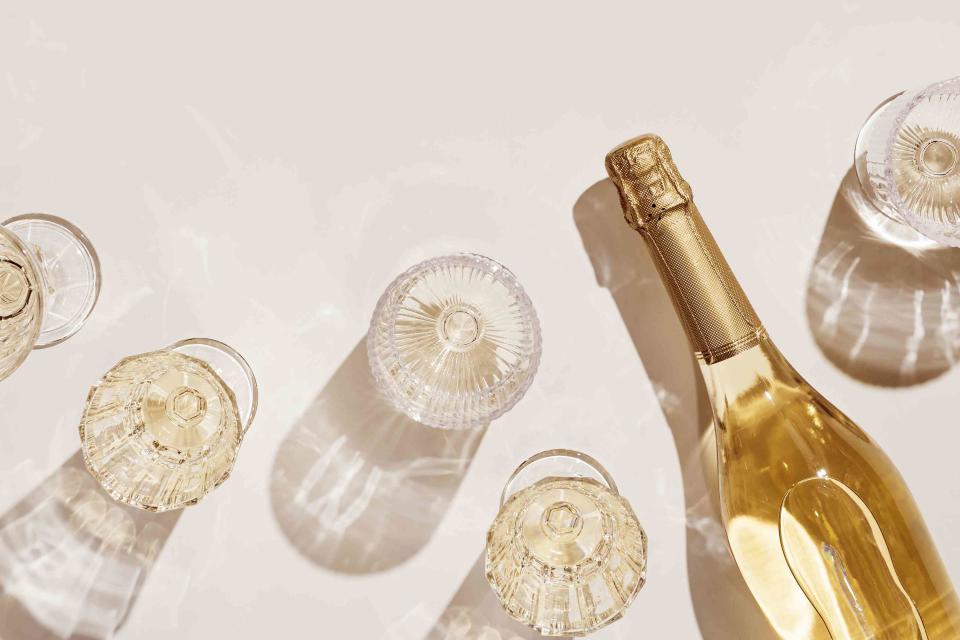Cava Is The Sparkling Sipper You Should Be Drinking This Season
This Spanish sparkling wine may not have as much name recognition as its French cousin, but it should.

Getty Images
Special occasions call for a special drink. Whether it’s the holidays, a birthday, or a milestone to be celebrated, popping a bottle of Champagne seems to make every day a bit more elevated.
However, there is another sparkling sipper that should make it to your table this year—Cava. Misunderstood as a beverage and usually placed within the same category as Prosecco or other sparkling wines, one will find that Cava is the best of both worlds. It brings the complexity, effervescence, and flavor profile of Champagne with a budget that is more in-line with Prosecco.
Celebrate With Cava
Spain’s answer to Champagne, Cava is traditionally made from the Xarel-lo, Macabeo, and Parellada grapes, all native to the country. These are sometimes assisted by Chardonnay, Pinot Noir, or several other grapes. And, just like Champagne, Cava is made in the traditional method, meaning that it requires a second fermentation in the bottle and then allowing that to age.
According to Spanish wine brand Marqués de Cáceres, this method leads to greater complexity, richness, and delicious notes of brioche on the palate.
"Champagne has been marketed for a longer period thus buying vineyards in France can be very expensive. While Cava has also been made for centuries, it’s now gaining popularity in the U.S. wine market,” says Jeff Jenssen, a wine educator and co-author of five books, including White Wine.
It's Very Food-Friendly
Sometimes, you don’t know what you’re making until closer to a party. And sometimes you have to make last-minute adjustments to the menu. But, if you choose Cava as your drink pairing, you’ll not have to worry about the wine not pairing correctly.
Sparkling wines like Cava, have naturally high, mouth-watering acidity, which translates to ample pairing possibilities—perfect for a holiday table with a wide array of flavors.
Winemaker Eva Plazas Torné of Vilarnau notes that Cava is perfect to start with, as the bubbles have a refreshing impact on the palate and prepare it for food. But, she explains, this Mediterranean-style wine can be produced in a Brut Nature style, with balanced acidity and zero added sugar.
"This makes Cava a great pairing with foods that are difficult to combine, such as green asparagus, artichokes, endives, even sauces with vinegar. And, Cava is one of the most versatile wines that it can be combined with an infinite number of dishes: current, avant-garde, traditional or modern cuisine,” she says.
It's Special, Too
Cava has specific rules it must stick to when it comes to aging. Cava must be aged for a minimum of nine months to receive the Cava de Guarda certification. After that, Cava producers can achieve Cava de Guarda Superior certification when aged between 18 and 36 months.
However, this bright sparkler can be aged for more than 36 months, adding to its complexity and achieving a high-quality wine that you will be pleased to both serve or gift. This is the Cava de Paraje certification, which has its very own quality stamp style and has very strict additional qualifications on production yield and must be estate-made.
"Cava is so well priced that it doesn’t have to be reserved for special occasions, but when you do have a special occasion you should have a special Cava," says Jenssen.
It's Perfect for Punch
While the flavor of Cava is truly too special to hide in a cocktail, it does make for the perfect punch topper, especially for the holiday season.
"Whenever you’re preparing a batch drink with Cava, you always want it to be bubbly when you serve it to your guests. That’s easy with Cava because it has a high number of persistent bubbles due to the second fermentation that occurs inside each bottle,” says Jenssen.
He suggests pre-batching all of the other ingredients and then topping your guests off with some fresh, cold Cava directly from the bottle to prevent the bubble from sitting too long and going flat. "It’s a great way to say welcome," he says.
For more Southern Living news, make sure to sign up for our newsletter!
Read the original article on Southern Living.

